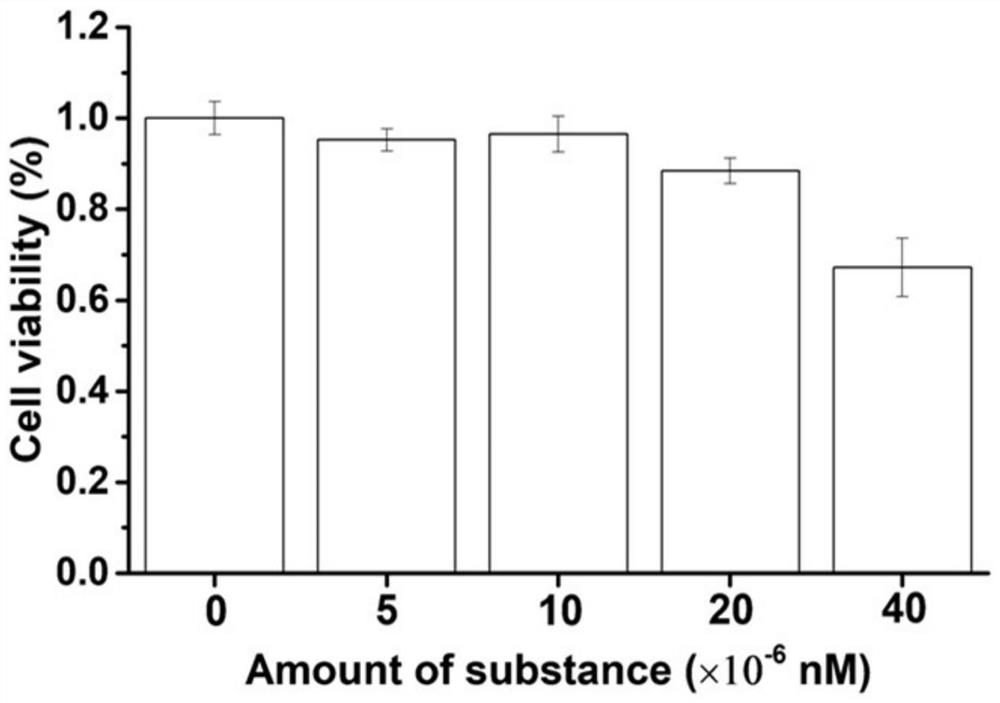Hypoxia response gene editing method
A gene editing and responsive technology, applied in the field of hypoxia-responsive gene editing, which can solve problems such as thermal damage
- Summary
- Abstract
- Description
- Claims
- Application Information
AI Technical Summary
Problems solved by technology
Method used
Image
Examples
Embodiment 1
[0023] A hypoxia-responsive gene editing method of the present invention comprises the following steps: mixing the hypoxia-responsive nanocomposite APACP with cells containing a target gene, the sequence of the target gene being: 5′-ATTCCCTGTCACCGCGTCAC-3′, p-carboxyl The specific reduction of azobenzene in the hypoxic microenvironment of the tumor leads to the breakage of the azo bond. Under hypoxic conditions, the Cas9 / sgRNA covalently linked to the hypoxia-responsive nanocomposite APACP is precisely and controllably released. And based on the CRISPR-Cas9 system, effective gene editing is realized, and tumor site treatment is realized under infrared light irradiation, and the target gene has the nucleotide sequence shown in SEQ ID NO.1.
[0024] The target genes include EGFP gene and HSP90α gene, the cells are A549 lung cancer cells, and the mice are BALB / c nude mice. In the tumor hypoxic microenvironment, the N-N double bond is destroyed, and the Cas9 / sgRNA complex is releas...
Embodiment 2
[0030] The preparation method of the hypoxia-responsive nanocomposite APACP of the present invention:
[0031] Preparation of gold nanorods AuNR5×10 by CTAB-mediated seed growth method-9 nmol, 0.0040g mercapto-polyethylene glycol-amino SH-PEG-NH 2 React with AuNR solution at 37°C for 12 hours to obtain SH-PEG-NH 2 -AuNR; 0.0036 g p-carboxyazobenzene activated with 0.0384 g N-ethyl-N'-(3-(dimethylamino)propyl)carbodiimide EDC and 0.0058 g N-hydroxysuccinimide NHS The carboxyl group of the carboxyl group was added for half an hour, then the p-carboxyazobenzene solution was added to the product obtained in the previous step, and incubated overnight at 37°C to form APA; at room temperature, in Tris-HCl buffer, 2.5 μg Cas9 protein was mixed with Incubate 7.5 μg sgRNA for 10 minutes to form Cas9 / sgRNA complex, mix activated APA with Cas9 / sgRNA complex, and store in a refrigerator at 4°C overnight, add PEI solution at a mass ratio of 5:1 to sgRNA The ratio of was transferred to the...
Embodiment 3
[0036] A hypoxia-responsive gene editing method of the present invention comprises the following steps:
[0037] Using CTAB-mediated seed growth method to prepare gold nanorods (AuNR), 0.0040g mercapto-polyethylene glycol-amino (SH-PEG-NH 2 ) reacted with AuNR solution at 37°C for 12 hours to obtain SH-PEG-NH 2 -AuNR; activation of the carboxyl group of p-carboxyazobenzene with N-ethyl-N'-(3-(dimethylamino)propyl)carbodiimide (EDC) and O-hydroxysuccinimide (NHS) After half an hour, the p-carboxyazobenzene solution was added to the product obtained in the previous step and incubated overnight at 37 °C to form APA. Cas9 protein was incubated with sgRNA at a Cas9:sgRNA weight ratio of 1:3 in Tris-HCl buffer (pH=7.4) for 10 min at room temperature to form a Cas9 / sgRNA complex. The activated APA was mixed with the Cas9 / sgRNA complex and stored in a refrigerator at 4 °C overnight. The PEI solution was transferred to the above product at a weight ratio of 5:1, and the final produc...
PUM
 Login to View More
Login to View More Abstract
Description
Claims
Application Information
 Login to View More
Login to View More - R&D
- Intellectual Property
- Life Sciences
- Materials
- Tech Scout
- Unparalleled Data Quality
- Higher Quality Content
- 60% Fewer Hallucinations
Browse by: Latest US Patents, China's latest patents, Technical Efficacy Thesaurus, Application Domain, Technology Topic, Popular Technical Reports.
© 2025 PatSnap. All rights reserved.Legal|Privacy policy|Modern Slavery Act Transparency Statement|Sitemap|About US| Contact US: help@patsnap.com



